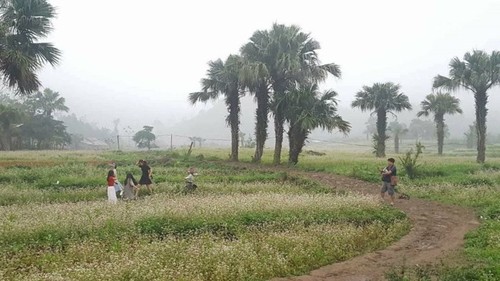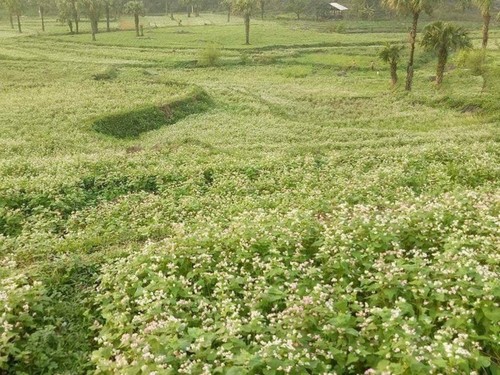|
 A buckwheat flower field leads to Ten Hamlet. A buckwheat flower field leads to Ten Hamlet.
(Photo: baotainguyenmoitruong.vn)
|
Ten hamlet is 1,200 meters above sea level. It is in the highest, least accessible area of Thai Nguyen province.
A field of buckwheat flowers at the hamlet’s center welcomes visitors. Nguyen Van Vi, a visitor from Hanoi, said: “The culture in Ten hamlet is very special. Before the visit, we knew very little about the customs of the Mong people. Here I’ve learned lots of very interesting things.”
Visitors to Ten hamlet enjoy listening to the panpipe, a typical part of the local culture.
Pham Quang Linh, Deputy Chairman of the People’s Committee of Dong Hy district, said: “The Mong ethnic heritage needs to be preserved. We intend to teach the younger generation our panpipe melodies so they can preserve this heritage.”
Another attraction of Ten hamlet is its food. At this year’s Mong culture and sports festival, the Mong hamlets cooked “mèn mén”, steamed minced corn, and “thắng cố”, a dish made from horse meat and organs.

The buckwheat flower field in Ten Hamlet. (Photo: baotainguyenmoitruong.vn)
|
Ly Van Mung, a resident of Ten hamlet, says once you try it, you will never forget it.
“All dishes are prepared and cooked hygienically for tourists. After tasting the food, all of them agree that the dishes are delicious,” Mung said.
During their festival, the locals play folk games like top spinning and nightingale fighting.
The festival is seen as a way to improve living conditions in these mountain villages.
Linh said Dong Hy district has more than 500 Mong families with more than 2,700 people who are determined to preserve their traditional culture.
“Over the years, we have changed the face of Dong Hy district and Van Lang commune. Roads have been built that lead directly to the hamlet. Ten hamlet has also been connected to the electric power grid,” said Linh.